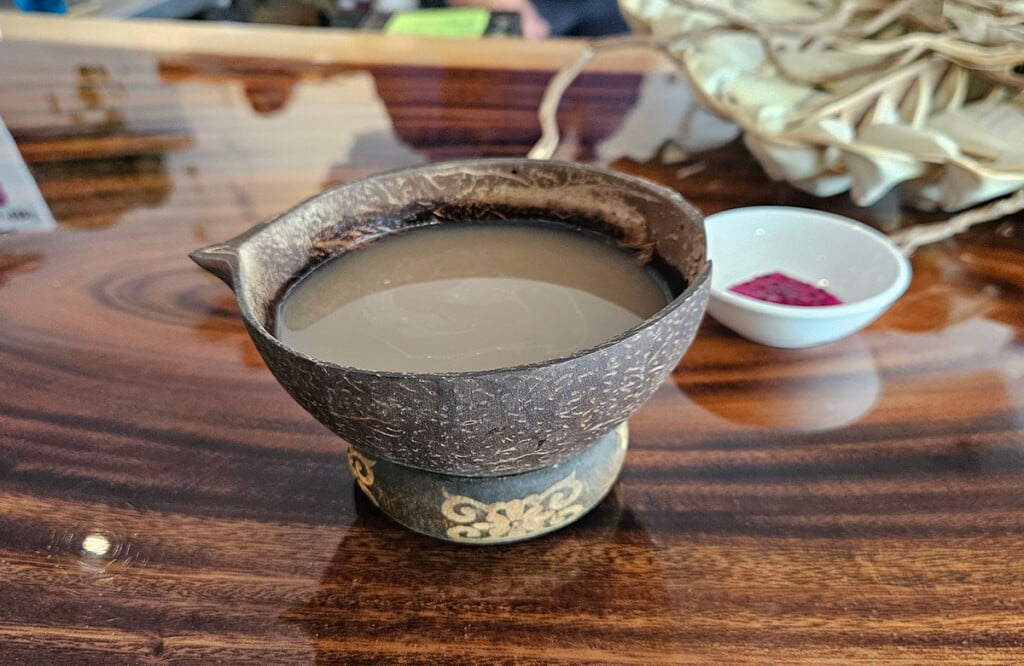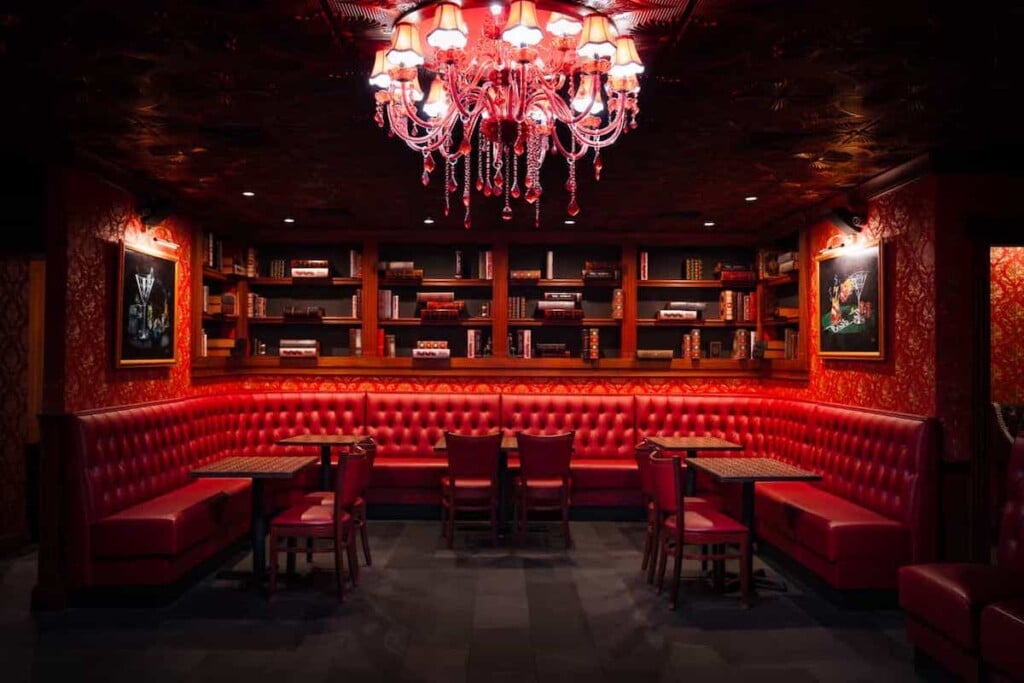Dancing the Finnish Tangö
There’s no lutefisk at Göran Streng’s new Kakaako restaurant—just upscale comfort food.

Göran Streng’s sauteed moi on tomato fennel coulis and ratatouille is not everyone’s idea of home cooking, but it’s comfort food nonetheless.
Photo by Alex Viarnes |
The last time I saw Göran Streng, he and his family were serving up breakfast, char siu chicken fried rice with eggs and Portuguese sausage, for $5.50 at the Kapiolani Farmers Market. Then I spot him, newly bearded, working the display kitchen of a brand-new restaurant, Tangö. Last I’d heard, the restaurant had been delayed for months and months. Here it was, lights on, burners lit, tables full.
“Göran, you never tell me anything,” I complained.
“We’ve been trying to open quietly, no publicity,” he said. “Last Saturday was our first night. We didn’t tell anyone, and we got slammed anyway, 100 covers. People from the building.”
The building. Streng’s new restaurant is on the ground floor of Hokua, next to P.F. Chang’s. It must be one of the best restaurant locations in the state. Not only is it right in the center of the whole Ward/Ala Moana complex, with ample parking, but it has 248 condos (average resale price: $3,009,472.22) perched right on top of it.
“I wanted a neighborhood joint,” says Streng. “But this is a pretty good neighborhood.”
The location—Streng refers to Hokua as “the Halekulani of condos”–set off a delicate balancing act. The little 50-seat restaurant had to be elegant, upscale, “nice” enough for the building. At the same time, says Streng, “I didn’t want it to seem like a fancy restaurant. I didn’t want to intimidate anyone from walking in off the street.”
Many people have tried to create what Streng was after—casual, unpretentious fine dining. That was the idea, you’ll remember, behind George Mavrothalassitis’ Cassis. Cassis had a talented chef and stunning pastry chef, but it was supposed to be casual, and wasn’t. It was far too much restaurant for its downtown location.
It’s hard to hit that casual note. Perhaps the last restaurant to hit it perfectly in Honolulu was the old Swiss Inn. Everyone wants a place where eating is no big deal, you feel you could go everyday, but the food’s still great.
Tangö aspires to be just that place. It succeeds from an unlikely combination of ingredients, one of which is Finland.

Like Göran Streng himself, his new restaurant has a slight Finnish accent, like the Marimekko wall hangings behind him.Photo by Alex Viarnes |
Streng was born and raised in Finland. Although he’s lived in Hawaii longer than he lived in Scandinavia, you can still hear from time to time an accent in his voice—“over dere, togedduh.” Tangö has that slight Finnish accent as well.
First, in the name, which has nothing do with the Argentine tango. It’s a portmanteau word, combining the first names of Streng’s business partner, Tami Oroxco, and Streng himself, which explains that little umlaut over the final o.
There’s also a faint Finnish tinge to the décor. The fabric panels are a famous ’60s floral design—unikko—from the Finnish design house Marimekko. A planter full of birch trees splits the dining room down the middle.
Tangö is an increasing rarity in Honolulu, a chef-driven restaurant, in the sense it has a chef owner.
I doubt many people in Hawaii know Finland well enough to be reminded of it. But somehow the décor works, even things like Streng’s decision to use a few wooden picnic tables instead of booths. “I wanted it to look rustic,” says Streng.
Tangö’s hardly a Scandinavian restaurant. “No lutefisk,” laughs Streng, lutefisk being a particularly nasty kind of fishcake created by soaking cod in a bath of lye made from birch ash.
However, Streng did get his culinary start in a restaurant outside Helsinki called Hwitträsk (you have to love Finnish names). Hwitträsk is a famous log-cabinlike structure, half museum, half small restaurant. “At long last, I’m back in a kitchen that small,” he says, “and I tell my crew, the advantage is, you have to learn to do everything.”
The other lesson he took away from Hwitträsk was regionalism. Somehow, in the arrogance of contemporary cuisine, eating locally sourced foods seems like a new idea. “We had to eat regional ingredients in Finland,” laughs Streng. “It’s all we had. That’s where I learned to cook with mushrooms.”
Ingredients may be best if they are regional, but cooking’s international. At 21, Streng took off to see the world. First, Yugoslavia, then California. Was he influenced by contemporary California cuisine? No, he says; in Palo Alto he was influenced by motorcycles and living the good life.
You have to like Streng’s traditional touches, in this case, crostini slathered in garlicky aioli, set on top the mild broth.
He shipped his motorcycle to Hawaii in 1984, and labored in some first-rate kitchens—the Third Floor at the old Hawaiian Regent, Halekulani, Ritz-Carlton Mauna Lani. He cooked with the luminaries of Hawaii Regional Cuisine—Philippe Padovani, George Mavrothalassitis, Jean-Marie Josselin, but in the early ’90s, as the HRC movement came to the fore, wanderlust hit Streng again. He was in Singapore, reopening the legendary Raffles Hotel.
“I don’t know if I would have been asked to join the HRC movement, I was still an executive sous-chef,” he says. “But, yes, I learned from them.”
Then, back in Hawaii, he took top slots at the Kapalua Bay Hotel, the Mauna Kea Beach Hotel and finally the Hawaii Prince. It was at the Prince and the Mauna Kea that he met special events coordinator Tami Oroxco, who was eventually going to become his partner.
“It was inevitable,” she says. “We did so many big projects together, like lunches for 2,500, and our thinking was always the same. It was like we were the right brain and left brain.”

A grilled salmon is Tangö’s most popular lunch item.Photo by Alex Viarnes
|
Which was right and which was left? Oroxco just laughs. “Depends on which day.” The most creative, “right-brain” function in a restaurant is usually the cuisine. But Oroxco likes that Streng’s food is so straightforward. “What it says on the menu, that’s what you get. This restaurant has easy, home cooking.”
Oh, sure. It’s easy, home cooking, if you happen to be a hotel chef with nearly 40 years of experience. Sautéed moi with tomato fennel coulis, mustard herb crusted rack of lamb, duck breast in spicy wine sauce, lobster and goat cheese ravioli—that’s perhaps Streng’s idea of simple food. It’s most people’s idea of high-end dining.
“There was lots of ambiguity for me coming up with the menu,” says Streng. Tangö is an increasing rarity in Honolulu, a chef-driven restaurant, in the sense it has a chef owner. But, says Streng, he didn’t have a menu in his back pocket that he was looking to cook somewhere.
“At this point, I can cook anything,” he says. He let the location dictate his menu, cooking up healthier items like grilled salmon on Nalo Greens for lunch and, for dinner, he also insists on, “regular comfort food, nothing fancy.”
In a sense, he’s right. There’s no foie gras, no caviar, no complex layers of flavor—just straightforward dishes.
Recently ReviewedHere are some things John Heckathorn had to say in past months. Go to our Dining page to read more reviews!• PearlAla Moana Center,  Reviewed in our
• Dat One Persian
|
His bouillabaisse, for instance, is quite mild, the biggest flavor pow coming from the generous number of mussels. The rest is pleasant, easy to eat—chunks of mahimahi, red potatoes, prawns, a garnish of fresh dill. You have to like Streng’s traditional touches, in this case, crostini slathered in a garlicky aioli, set on top the mild broth.
There’s a little nod toward Finland. Roasting salmon on a cedar plank is a traditional Scandinavian recipe. Here, Streng changes it up. He does an eight-ounce sirloin on a cedar plank, which emerges from the oven slightly charred and smoking. The plank imparts a definite smoky edge to the meat. In lieu of a sauce—here’s another traditional touch—the steak comes with a compound herb butter, an old hotel trick for livening up grilled meats.
To show the range of Streng’s cooking, however, there’s a second beef dish. If his first has its roots in Finland, the second is all Hawaii—an Asian-style braised beef with five spice, that potent Chinese combo of cinnamon, cassia, star anise, ginger and cloves. “It must be comfort food,” insists Streng. “It’s our second most popular item.”
The most popular? Streng’s risotto. Nothing terribly fancy, just a rich cheesy risotto, made with chicken broth, dotted with Hamakua mushrooms, and topped with grilled shrimp and jade-green asparagus.
Comfort food? If you’re looking for food your mother made, probably not. But the risotto is one of the most comforting dishes I have had in a long time, rich without being overwhelming, flavorful without being distracting, soft and warm, but topped with contrasting textures. It would be especially suited, I think, to a glass of pinot noir.
I was, however, drinking a glass of zinfandel, with which Streng was kind enough to gift me. He couldn’t sell me a glass, because, given the maddening slowness of the permit process in Honolulu, he didn’t have a liquor license yet. Since the wheels of bureaucracy grind exceedingly slowly, you may wish to check and see if you need to bring your own wine.
Except for an ice cream cake made by Maurice Grasso of La Gelateria, Streng also makes all his own desserts. Once again, straightforward stuff, the richness of a crème brûlée set off nicely by a touch of lemon verbena, and a little round bread pudding, which were his signature desserts at the Prince.
However, allow me to linger a little over the crêpes, quartered and filled with a warm berry compote that positively sang of summer, touched with citrus, so rich with berry flavors it reached up into some flavor memory bank and said, all is right.
The most comforting thing: appetizers are $5.50 to $8.50, entrées in the high teens and low 20s, desserts $4.50 to $6. Our check for three, $116.
The only reason Tangö is not perfect? At parties, I’ve seen Streng make a Finnish dish that was essentially a whole bag of dried morel mushrooms in a heavy cream sauce. It would bring tears to your eyes. “Oh, it’s too expensive for our menu,” he says. “I’ll have to combine it with something less pricey.” Encourage him.
John Heckathorn has been writing restaurant reviews for HONOLULU Magazine since 1984. In 2007, he won a bronze medal from the City and Regional Magazine Association for his food writing.








